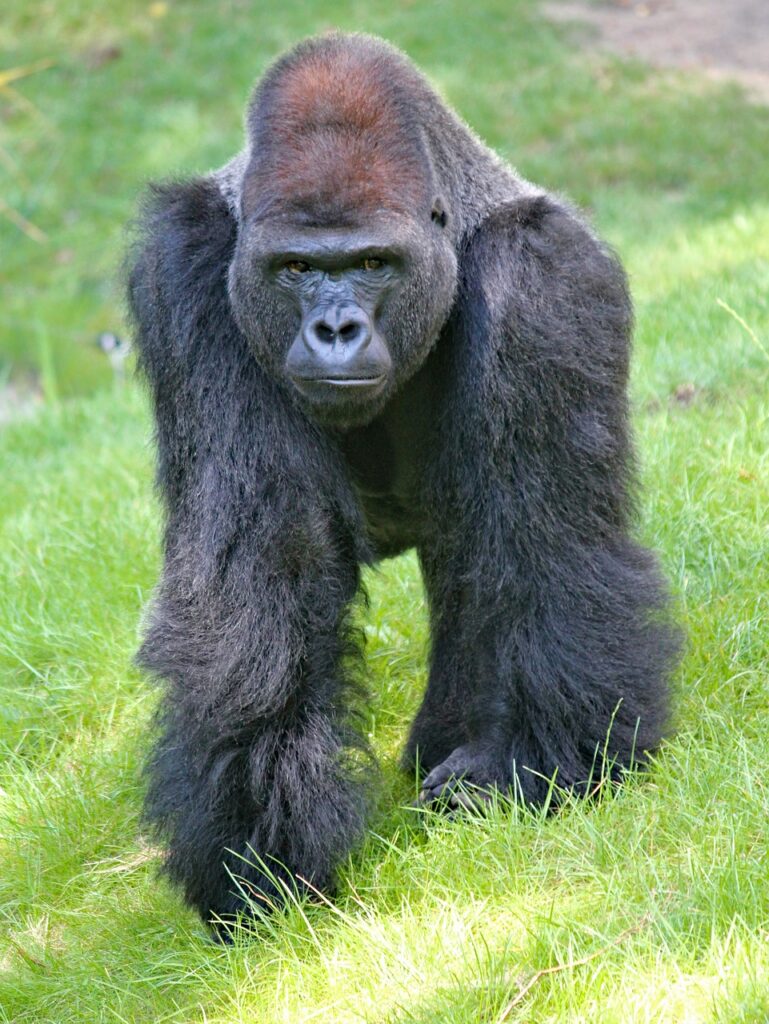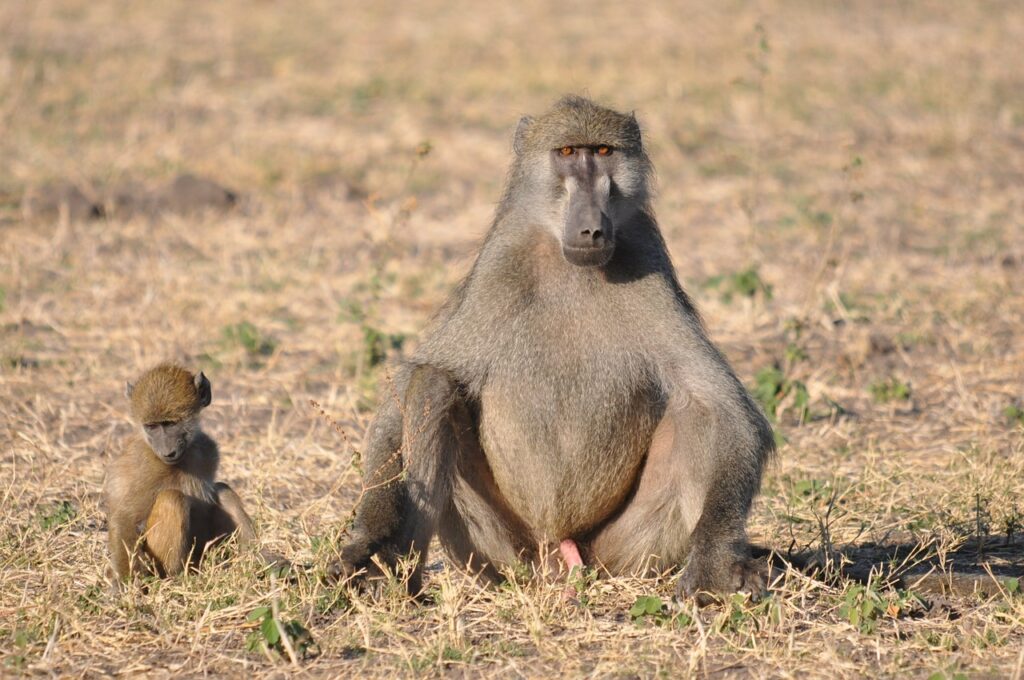WHAT IS THE DIFFERENCE BETWEEN A GORILLA AND A BABOON?
Gorillas and baboons are two of the more popular and familiar representatives of the Primate order. Primates occupy a special place in our imagination because the human race belongs to this taxonomic order. We share common attributes with the monkeys.
The gorilla and the baboon are among the iconic animals in the African continent. But what are the main differences between gorillas and baboons?
Let us compare these two primates.
WHAT ARE THE ATTRIBUTES THAT SEPARATE GORILLAS AND BABOONS?
1. TAXONOMY
The gorilla is the most famous of apes. It is hard to ignore the image of a gorilla, considering that it is the largest non-human primate. Biologically, the gorilla shares a common ancestry with chimpanzees and humans. The common lineage among these three can be traced to a single evolutionary source that branched out approximately 7 million years ago. Overall, there are four existing subspecies of gorillas: the mountain gorilla, the Eastern lowland gorilla ( Gorilla, beringei graueri ), the Western lowland gorilla ( Gorilla gorilla gorilla ), and the Cross River Gorilla ( Gorilla gorilla diehli ). All of these subspecies are native to the African continent.
The baboon is one of the existing 23 genera of Old World Monkeys. Old World Monkeys are recognized for their downward-oriented noses, non-prehensile tails, opposable thumbs, and African and Asian ancestry. In contrast, New World monkeys have flatter noses, prehensile tails, non-opposable thumbs, and rootedness in America. There are five existing species of baboons:
- The hamadryas baboon ( Papio hamadryas )
- The Guinea baboon ( Papio Papio )
- The olive baboon ( Papio Anubis )
- The yellow baboon ( Papio cyno cephalus )
- The chacma baboon ( Papio ursinus )
2. HABITAT
Gorillas are endemic to Africa. The Eastern lowland gorilla is native to the forests in the Congo region. They tend to roam across large and diverse terrains, which include primary forests and peat wetlands. Mountain gorillas can be found in the Central African and Ugandan regions. They frequent high-altitude cloud forests. Western lowland gorillas are populous and are found in more territories than the eastern gorillas. They can be found in all sorts of forest systems, ranging from montane ecosystems to dense primary areas. The Cross River gorilla is named after the territory where it is native. They inhabit the forests along the Nigeria-Cameroon area.
Being Old World Monkeys, baboons are endemic to Africa and the Arabian Peninsula. They travel in relatively large troops across the large and open spaces of the African savannah. They are also arboreal, mostly using the taller trees as night shelters inaccessible to most predators. The hamadryas baboon is native to the Arabian Peninsula as well as the Horn of Africa. Guinea baboons can be found in western Africa. Olive baboons cover large spaces when they move in search of food and shelter. They can be found all over the African continent. The yellow baboons are primarily native to eastern Africa. Finally, the chacma baboon is found in the southern regions of the continent.
3. SIZE AND APPEARANCE
Gorillas are massive apes. The Western lowland gorilla is the smallest of the four gorilla subspecies, but its adult males still stand at impressive averages of 6 feet in height and 300 pounds. In contrast, the Eastern lowland gorilla male averages around 6 feet and 5 inches in height and 450 pounds. Gorillas are barrel-bodied. Their bodies are covered in dark hair, which, depending on the subspecies, may vary from darker shades of gray to deep black. They seem to have the appearance of slow-moving creatures, but they are deceptively agile and fast. Gorillas are quadrupeds, meaning that they walk on all four limbs. But they are also capable of bipedal locomotion, albeit across short gaps only. When they move on all fours, they press down on the ground through their knuckles. The biological explanation for this type of movement is that the fingers and the opposable thumb are tucked in to protect. Gorillas, along with the other apes, rely on fine motor manipulation with their fingers. This is why knuckle-walking is advantageous.

Baboons possess deeply-set and intelligent-looking eyes, long muzzles, prominent jaws, hairless and callused buttocks, and long but non-grasping tails. Males are significantly larger, longer canine teeth and a more elongated muzzle. They walk on all four limbs. But they can stand upright over a short period. They have opposable thumbs, which allow them to quickly move up trees and higher ground.

4. DIET
Gorillas are mostly vegetarian. They will spend long hours each day foraging and feeding on leaves, shoots, and the softer portion of trees and foliage. They will also eat fruit on occasion. The Eastern and Western lowland gorillas supplement their usual diet of greens and fruit with insects, particularly termites and ants. They will also feed on larvae. Interestingly. Gorillas get much of their daily fill of water from the moisture in the plants they feed on.
Baboons are omnivorous. They tend to eat leaves, roots, fruits, and seeds. But they are also opportunistic predators that will eat and hunt small birds and rodents. They can also hunt in groups to take down more challenging prey, such as the younglings of antelopes. They will also cannibalize on smaller monkeys. Baboons have adapted well living near human settlements, to the point that they are not shy to raid and feed on livestock.
5. SOCIAL BEHAVIOR
Baboons are social animals. They live in relatively large groups referred to as “troops.” Baboon troops are large, with populations ranging somewhere between 30 to 300 members. Except for hamadryas baboons, all baboon subspecies maintain a matrilineal hierarchy. While mature males tend to leave the troop, females are life-bound.
It is not uncommon for members and generations of the troop to be related to a single matrilineal line. Because baboons travel across great distances and are under constant threat of predators, they evolved a group behavior based on protection and cooperation.
Baboons move with purpose and discipline. They maintain a well-defined perimeter whether they are resting or moving. The mature and more dominant males move at the group’s center to keep the younglings in check. Their presence is a calming factor for the troop. Younger males man the perimeter, protecting the females as well as the juveniles. When baboons rest or sleep, they tend to seek high ground or tall trees while maintaining their perimeter and hierarchy.
Gorillas have a more simple social structure. They are organized in a harem-like structure, with the male silverback at the top and center of the hierarchy. The silverback leads about 3 to 6 females and several younglings. The silverback is expected to maintain his authority over the group in various ways. This includes leading the group to areas where food is abundant and less threat from competing species and predators. The silverback must also protect the harem from danger. The females tend to live the harem if the silverback fails at upholding his status and his presence. One unique behavior observed among gorillas is nesting. When they retire for the day, gorillas will gather leaves and twigs around them, forming a barrier of warmth. Each gorilla builds its own nest and does not share it with others. The exception to this are females and their offspring.
6. CONSERVATION STATUS
Of the four gorilla subspecies, the mountain gorilla is classified as “endangered”. Their numbers have significantly dwindled due to poaching activities and the encroachment of human presence into their natural habitats. As of 2020, there are only 880 mountain gorillas left in the world.
Baboons are classified as “threatened.” But each of the five baboon subspecies has stable populations so that there is no imminent possibility of extinction shortly.
Questions and Answers
- DO GORILLAS ADAPT WELL IN CAPTIVITY? There are some debates as to whether gorillas thrive in captivity or not. In the wild, the average life expectancy for gorillas is between 30 to 40 years. But in captivity, they have been known to live for around 50 years. In recent times, because gorillas are at risk of becoming extinct, there have been initiatives to move and raise them in controlled environments where they may have some chance to restore their numbers.
- DO BABOONS ADAPT WELL IN CAPTIVITY? Yes. Baboons also seem to thrive well in captivity. In the wild, they are expected to live for around 30 years. But in captivity, baboons have been observed to extend their life expectancy to 40 years.
- DO GORILLAS INTERACT WELL WITH PEOPLE? Yes. Although silverbacks can be very aggressive, gorillas, in general, have a gentle nature. In both the wild and captivity, gorillas have displayed not only sharp intelligence but also tractability. Along with chimpanzees, gorillas can be taught sign language, which allows them to communicate clearly and effectively with humans.
- DO BABOONS INTERACT WELL WITH PEOPLE? Yes, up to the point when they can potentially become a nuisance. Baboons are opportunistic predators and foragers. They see human settlements as abundant sources of food. They are known to steal and raid houses and farms for food. In ancient Egypt, baboons are tolerated in villages and urban centers because they were considered deities.
- WHAT IS THE GORILLA’S NATURAL PREDATOR IN THE WILD? Due to their size and the remoteness of their natural habitats, gorillas do not have a natural predator. The exception to this is the leopard. There are accounts of leopards hunting gorillas.
- WHAT IS THE BABOON’S NATURAL PREDATOR IN THE WILD? Baboons face few threats in the wild because of their tightly-knit social structure. That being said, the primary threat to the baboon in the wild is the big cats. Lions, leopards, and cheetahs will hunt baboons when the opportunity is there.

